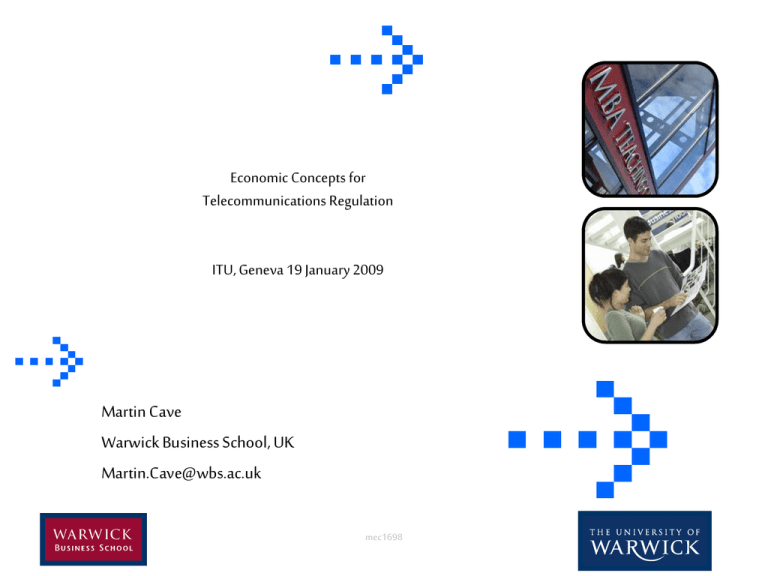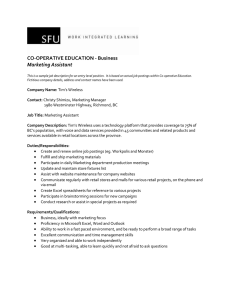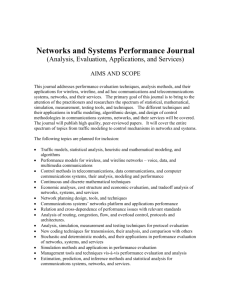Martin Cave Warwick Business School, UK Economic Concepts for
advertisement

Economic Concepts for Telecommunications Regulation ITU, Geneva 19 January 2009 Martin Cave Warwick Business School, UK Martin.Cave@wbs.ac.uk mec1698 Agenda 1. Sources of market failure Q&A Break 2. Policy responses for economic regulation Q&A 3. Instruments of social regulation Q&A 2 mec1698 Economic Concepts for Telecommunications Regulation Part 1. Sources of market failure. 3 mec1698 Defining the optimum position Benefit, Cost, Price Marginal utility, willingness to pay P* Marginal resource cost Q* At Q*, marginal utility = marginal resource cost. This is the optimum 4 mec1698 Call minutes The competitive yardstick Benefit, Cost, Price S P* D Q* If telecoms markets were fully competitive, we would observe the optimum. But they are not…. 5 mec1698 Call minutes The problem of market power Price per minute P** P* D Q** Q* The monopolist can make more money by raising price (to P**) and cutting output (to Q**). A basic tack of regulation is to stop this happening. 6 mec1698 Call minutes Where does market power come from? A. Law and regulation - statutory monopoly - restrictions on availability of licences - withholding spectrum B. Features of the cost structure (which vary between wireless and wireline networks) C. Interconnection obligations. 7 mec1698 Fixed network cost structure Contestable Core Backhaul S1 S2 Access S5 S4 S3 Scope for competition also depends on size of market 8 mec1698 Natural monopoly Wireless network cost structure Total cost Capacity expansion Cost of coverage Mobile networks tend to be ‘natural oligopolies’, and licensing policy often strengthens this trend 9 mec1698 Call minutes Economies of scope and multi-service networks Different services used to be provided by different networks: telecommunications for voice calls, cable networks for broadcasting. New digital networks can provide voice and data services cheaply on a single network (economies of scope); this works against wireline competition. However, competition among different types of network (wireline, wireless, satellite) impose additional competitive constraints. 10 mec1698 Interconnection and market power interconnection Caller Origination Termination Receiver To connect subscribers, competing networks must interconnect. Callers may have a choice of originating networks, but the receiver’s chosen network must terminate the call. If the caller pays the whole cost of the call (calling party pays), the receiver’s network can exploit its bottleneck control. 11 mec1698 Externalities I A. Narrow sense Telecoms services purchased by one customer may benefit others - Network externality: by joining a network a subscriber creates calling opportunities for existing customers - Call externality: under calling party pays, receiver benefits from call. Can be internalised by call rotation. 12 mec1698 Externalities II B. Broad sense Evidence that spread of (especially mobile) telecommunications speeds up economic growth. Possible conclusion: governments should subsidise (or avoid taxing) mould-breaking network roll-out of mobile voice services(1990s, 2000s), and of mobile and high speed broadband services (2010s). 13 mec1698 Information problems End users may make poor choices of service: - Buy wrong mobile package/bucket - Fail to find cheaper suppliers - Be unaware of download restrictions - Inadvertently buy international roaming. Solutions: mandate provision of information and/or control quality of service (see ‘net neutrality’ debate). 14 mec1698 Efficiency and equity The focus has been on efficiency – ie. correcting for market failure – and on the goal of replicating by regulation the competitive outcome. Governments also have equity objectives which regulation can further: - regional, urban/rural development policies - encouragement of small business - diversity. 15 mec1698 Economic Concepts for Telecommunications Regulation Part 2. Policy Responses for Economic Regulation ITU, 19 January 2009 Martin Cave 16 mec1698 Mandating interconnection Interconnection is necessary with multiple networks to gain the efficient ‘any to any’ property. The context and how it is done has major effects: - The interconnecting operators may or may not also compete - Charges, terms and conditions are important (eg. paid termination vs. bill and keep or peering) - It can be done in a way which is anti-competitive - It can be discriminatory (eg. international roaming) 17 mec1698 Competition among fixed networks – infrastructure vs. service competition (Separate end-to-end network) (Separate end-to-end network) Unbundled loop Unbundled loop Origination Bitstream Transit 18 Access to web Retail Retail The voice ladder The broadband ladder mec1698 Is infrastructure competition feasible or desirable? Benefits Costs Product differentiation Duplication of resources-infeasible in some geographies Less need for regulation Loss of economies of scale Exploits legacy networks Continued need for regulation More dynamic benefits Harder to achieve social objectives. 19 mec1698 One means of finding a balance The regulator can adopt the following approach: - Maximise entry (minimise barriers in wireless); In fixed monopoly areas, allow/require resellers (ie entry into retail); Encourage infrastructure competition where feasible; Get competitors to ‘climb the ladder’- ie. take duplicated assets closer to the customer 20 mec1698 Implementing infrastructure competition in fixed telecoms Allow entry of all kinds Identify wholesale products to which competitors must have access to supply end users Mandate access at set price and terms and conditions where competitors need it Review the situation at regular intervals, ceasing to mandate access where at least some competitors have duplicated the assets. 21 mec1698 The European Union approach to deciding where to regulate access 1. Carefully define the retail markets (note: are fixed and mobile voice and data services in the same retail market?) 2. Ask if there is a competition problem without regulation (note: answer is often ‘yes’ with fixed, ‘no’ with mobile). 22 mec1698 The European Union approach to deciding where to regulate access (cont.) 3. Look in the value chain for the least replicable input – at the top of the ladderprobably the local loop. Suppose access to it were available to competitors on fair terms. Would the competition problem go away? If yes, stop- the problem has been solved. If no, repeat the process with next least replicable asset. Continue until regulation has resolved the competition problem (note: in the limit this might involve regulating the whole value chain, including retailing.) 4. 5. 23 mec1698 Regulatory remedies Standard one is to set price and terms and conditions at which the (wholesale or retail) service must be sold. This will typically be a cost-based price, based on the average forward looking cost of the provision of the service by an efficient operator – known as Long Run Incremental Cost or LRIC This can be calculated using a cost model, or proxied by international bench-marching. 24 mec1698 Incentive regulation Some regulators prefer to set a longer-term price trajectory or ‘price cap’, extending several years. This gives the firm an initial incentive to increase efficiency. The benefits then go to end users. Price, Cost Price set in advance New price control for next period Firm’s realised costs 2 25 4 mec1698 6 Years Other/alternative remedies Access prices can be set higher to encourage initial investment (see NGN slide below) Access prices must be public (a ‘reference interconnect offer’). All firms must pay the same access prices (no discrimination) The access provider must not discriminate in favour of itself by setting its retail prices at a level which drives out competitors. The access provider must keep separate accounts for its access products. 26 mec1698 Next generation access (NGA) networks Sub-loop Duct Unbundled loop 27 Bitstream Bitstream Access to web Access to web Retail Retail Current generation ladder NGA ladder mec1698 These offer high speed broadband access. They can be telecoms networks, upgraded cable or (possibly) wireless. NGAs offer different access points. There is increased interest in mandating access to passive assets such as ducts. Problems in regulating NGAs The point about NGAs is that they do not yet exist – their costs are not yet sunk. Operators have to be persuaded to forego the option of delay and of sweating the copper assets. This persuasion may involve: - maximising competitive pressure - offering regulatory concessions over new services - allowing risk-adjusted (higher) returns. 28 mec1698 Regulating termination As noted above, under calling party pays (CPP), each terminating operator is a monopolist. This has led to regulation (heavily resisted by mobile operators!) of termination at cost-based prices. Currently, discussion is turning to alternatives based on lower regulated rates, negotiated rates or the introduction of bill and keep. This is a major component of the deregulatory project. Watch this space! 29 mec1698 Regulating wireless networks Apart from termination issues, mobile networks are potentially competitive. The thrust of regulatory policy should be to remove barriers to entry, as continuous entry upsets patterns of collusive behaviour. It is helpful to make available as much spectrum as possible, rather than maximise government revenues. Un-utilised military spectrum can also be deployed. In some countries problems with backhaul may require intervention. 30 mec1698 Is network separation helpful? A vertically integrated network can be separated in many different ways: - Separate accounts (to pin down cost allocations and generate sound access prices) Operational separation (to prevent non-price discrimination) Ownership separation (to remove any motive for discrimination). The latter two variants can have high costs, including the risk of discouraging investment, and so require full justification. 31 mec1698 Encouraging sharing of assets Mandating access to an incumbent’s facilities is a form of compulsory sharing ‘Voluntary’ forms include: - co-investment - Long-term contracts to buy access services. These can cover all assets: see ITU- Six degrees of sharing – Trends in Telecommunications Reform 2008. 32 mec1698 Deregulation – the competition law alternative Presumption of zero/limited regulation of mobile networks, if entry barriers can be removed; rebuttable in special cases – e.g. international roaming, (possibly) onnet/off-net call charges . The fixed services value chain (retail, transit etc.) can also be deregulated as infrastructure competition develops. Underlying dilemma is: how many competitors are needed before regulation is removed? (In US, 2+ wireless; in EU 4). Needs effective and speedy competition authority, to avoid excessive lags. 33 mec1698 Taxes Issue must be seen as part of overall fiscal regime Telecoms have positive externalities and are at crucial take-off point This makes the end user welfare loss from taxation (or regulation) high Also a risk of taxation above revenue-maximising level This suggests need to seek alternative sources of tax revenue if any exist. 34 mec1698 Economic Concepts for Telecommunications Regulation Part 3. Instruments of Social Regulation ITU, 19 January 2009 Martin Cave 35 mec1698 Arguments for intervention A. Social - Equity goals, such as the prevention of digital divide/regional inequalities - Services for disabled/disadvantaged - Citizenship motives B. Economic - 36 Enhancement of GDP, regional balance Call externalities, line externalities mec1698 Line and call externalities Line: existing subscribers benefit from new subscriptions. Hence case for offering subsidies to marginal subscribers, reflecting the value of their joining. Call: both participants benefit from a call, but under CPP, only the latter pays. Either subsidise the call or switch to Bill & Keep. Revenues to finance correcting subsidies can come from a variety of sources. 37 mec1698 The traditional ‘fixed line’ approach Objective is to maximise fixed line penetration. Achieved by below cost line rental (‘access deficit’) subsidised within monopoly firms by ‘excessive’ long distance and international call prices. Goal is universal availability and take-up at geographically averaged prices. 38 mec1698 Developing problems High call charges lead to inefficient network utilisation. Competitive entrants can ‘cream skim’ profitable heavy users – possibility of ‘graveyard spiral’ Problems can be resolved by optional tariffs for all users, including subsidised tariffs to low users. 39 mec1698 The wireless convulsion Wireless take up in areas of fixed coverage is now nearly 100%. Plus wireless reaches billions more, growing every year. Universal service should be seen as wireline or wireless service. Now recognised by, eg. European Commission. 40 mec1698 Universal service in a wireless world Service for individuals, not household (but can be shared – see ITU 2008 Can be achieved by licence condition imposed on all/many operators. Can be achieved by reverse auction process to choose a single retail or wholesale universal service operator, or by spectrum auction. 41 mec1698 Pros and cons of coverage requirements Pro: - guarantees desired level of access - pricing conditions can be imposed. Con: - bureaucratic process - creates excuse to limit competition - may be unnecessary: competition can do better, with appropriate spectrum policy - possibility of enforcement problems 42 mec1698 Broadband universal service Examples: Switzerland, Australia (98%), Singapore (100%), municipal investments Historically, universal service decreed when spontaneous take-up is 6080%. Choice of operator should be technologically neutral Can be done via reverse auction. 43 mec1698



